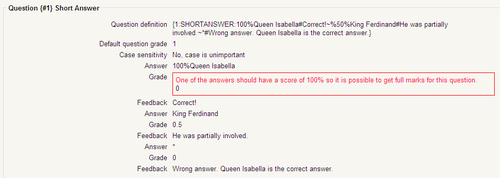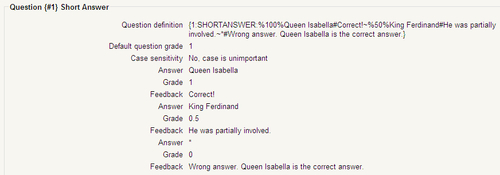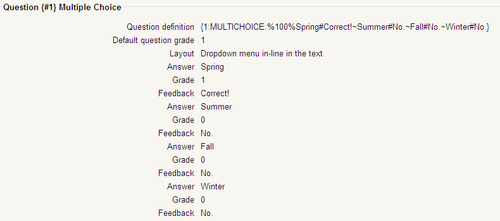Cloze is a question type that uses the cloze procedure to test reading ability. It does this by deleting words from a text and having the reader insert them. Moodle's Embedded Answers (Cloze) offers three item types, short answer, numerical questions, and multiple choice, which are embedded in a sentence, paragraph, or other piece of text. Cloze is one of the more difficult question types available in Quiz because you need to use a mark-up language to create these item. In Embedded Answers (Cloze), that mark-up language is called CLOZE. The CLOZE mark-up language is used to tell Moodle what to do with the text and how to display it. Here you have to use Moodle auto-format. When you save your text, Moodle will do a number of things to automatically format your text for you. For example, URLs such as http://yahoo.com or even www.yahoo.com will be turned into links. Your line breaks will be retained, and blank lines will start new paragraphs. Smiley characters such as :-) will automatically become their graphical equivalents. You can also embed HTML code if you want and it will be retained.
Cloze is a question type that uses the cloze procedure to test reading ability. It does this by deleting words from a text and having the reader insert them. Moodle's Embedded Answers (Cloze) offers three item types, short answer, numerical questions, and multiple choice, which are embedded in a sentence, paragraph, or other piece of text. Cloze is one of the more difficult question types available in Quiz because you need to use a mark-up language to create these item. In Embedded Answers (Cloze), that mark-up language is called CLOZE. The CLOZE mark-up language is used to tell Moodle what to do with the text and how to display it. Here you have to use Moodle auto-format. When you save your text, Moodle will do a number of things to automatically format your text for you. For example, URLs such as http://yahoo.com or even www.yahoo.com will be turned into links. Your line breaks will be retained, and blank lines will start new paragraphs. Smiley characters such as :-) will automatically become their graphical equivalents. You can also embed HTML code if you want and it will be retained.
Just to let you know, chances are you will make some mistakes when making these questions, especially if you are not familiar with Cloze. Don't worry, we'll walk you through the process and give you some tips on how to check your work.
There are two options for creating these questions: you can either write the code directly into the rich-text editor or you can import the files from somewhere else. We will start with the basics, showing the different formats for this item type and then we will show you how to import files.
Now, let's get started! For the first example, we'll be showing how to create a simple, fill-in-the-blank question inside a sentence, very similar to Short Answer.
Tip
Hot Potatoes
Many people feel that Hot Potatoes software is the easiest way to create Embedded answer (Cloze) questions. Once you have created your questions on your PC, you can then import them into Moodle's quiz module.
Hot Potatoes is a free software and allows for these questions to be created without learning all this syntax.
To start with, we want to create a new quiz. We'll call this test Embedded Answers (Cloze). We'll keep all the settings as default except for Adaptive, which we want turned off. We'll click on the Save and display button, which will bring us to the Add Questions to Quiz screen. In the Question Bank, we are going to switch the category to the new quiz we have just created, Embedded Answers (Cloze) and then go to the Create a New Question drop-down and select Embedded Answers (Cloze).
The first thing you might notice as you scroll down the page is that it is very short. There is very little for us to do here because all the information will be contained in the rich-text editor. All we really need to do outside the rich-text editor is provide the question name and offer general feedback.
For the question name, I am entering Queen Isabella sent Columbus on his voyage.
Now, we are going to start entering the mark-up. All parts of the question text that are not part of the response are outside the curly brackets All the actual mark-up needs to be inside the curly brackets { and }. Because the question begins with an embedded answer, we start by adding {.
The next thing we need to address is the point values of the item. We want this question to be worth the same weight as any other question, so we want to start by entering a 1 at the beginning, which will give it the same value as all other questions on the test, assuming we have left all the other questions equal.
We also want to make this a Short Answer-type question, so the next thing we are going to enter is SHORT ANSWER (each of the question type designators in Embedded Answers must be written in all capital letters), which will create the blank in the text. Immediately after the colon, we need to begin entering the possible responses.
In the blank, we want our students to write Queen Isabella, so we need to make sure we give a 100 percent grade for that answer. We begin by entering %100%Queen Isabella, which will score this response as correct and give it full points. We also want to give some feedback, so after that we type #Correct!. The # signifies the feedback received. The code will look like this: %100%Queen Isabella#Correct!
Now, we also want to give credit if a student writes King Ferdinand. However, since he wasn't the main person involved, we only want to give half-credit for this response, as well as a bit of feedback. We enter the code like this: ~%50%King Ferdinand#He was partially involved. Note the ~.This is used to separate answers.
Finally, we need to do something for feedback for all other responses. By entering ~*, we are saying that the response is not worth any points. For feedback, we want to make sure the student knows the correct answer. The code looks like this: ~*#Wrong Answer. Queen Isabella is the correct answer.
We have now added all the code we need for the response, so we need to close the code by adding a }. Now we need to finish the question by adding the rest of the text. After the } we type sent Columbus on his voyage.
Now, in the Question textbox we have the following CLOZE code:
{1:SHORTANSWER:100%Queen Isabella#Correct!~%50%King Ferdinand#He was partially involved.~*#Wrong answer. Queen Isabella is the correct answer.} sent Columbus on his voyage.
Tip
Copying from MS Word
Don't! When you copy and paste from Microsoft Word, some of that code comes along with it. It can cause your code to become corrupted and not function properly. If you don't want to use the Moodle HTML editor, use some kind of plain text editor.
Once we have entered this text, there is a button below titled Decode and Verify the Question Text. By clicking on this button, we will see if there are any mistakes. In fact, I purposely have made a mistake in the previous code so you can see what an error message looks like. Before you go on, look back at the previous code and see if you see anything that looks wrong. If you don't see it, not to worry. I purposely left off the % before Queen Isabella. By doing this, I created an error that the Decode and Verify button has picked up. The output is displayed in the next screenshot:

Looking at the red box around the Grade, we see the mistake. I have not given any answer the full possible points. 100%Queen Isabella is also clearly not a response I want to give credit for either. What I need to do is go back and add another % in front of the 100%Queen Isabella. This change will score the question as a correct response with full points. Here is the corrected code.
{1:SHORTANSWER:%100%Queen Isabella#Correct!~%50%King Ferdinand#He was partially involved.~*#Wrong answer. Queen Isabella is the correct answer.} sent Columbus on his voyage.
Once we go back and add the %, the Decode and Verify message no longer gives any errors. This means we can move on.

Now that we have entered in the code and verified that the question is working properly, we can save the question. In fact, Moodle will not allow you to save the question if there are any errors.
Now we want to preview it to see how it looks and how the responses work. We will go to the preview button and try each of the responses. Here is what the question and the correct response looks like.

Notice the floating feedback? You only see the feedback you entered when your mouse hovers over the answer. Make sure your students understand this point.
After we have confirmed that the question is working and there are no mistakes in spelling or in any other information, we move the question to the test. This is all you need to do to make a Short Answer-type Embedded Answer question.
Remember the Numerical questions discussed earlier? The Embedded Answer (Cloze) Numerical questions are very similar to the Numerical question type, but there are differences, mainly in the way they are created. Please be aware of this if you are using both types of questions.
The Numerical options in Embedded Answer (Cloze) are very similar to Short Answer. The difference is that any responses must be numerical and they may not include text.
Because this item is so similar to Short Answer, we will work through this together. I'll point out the differences as we come to them.
In the Question text, we need to create a bit of code, just like we did previously in Short Answer. We will enter 2+{1:NUMERICAL:%100%6#Correct~*#Sorry, the answer was 6.}=8. We will now scroll to the bottom of the page and click on Decode and Verify. Once we see that this formula is correct, we will save the question and then preview it.
As you can see, this is identical to the way we did Short Answer, except that I have entered NUMERICAL, which designates that the response must be numerical in nature. You may not enter non-numbers as the answer. If you do, the result will be considered incorrect.
Here is what the item looks like when completed correctly:

Here is what the question looks like when incorrectly answered. Note that the floating textbox is only visible if the incorrect answer is hovered over:
.jpg)
The other neat thing we can do with Numerical here, is just like what we did with the independent Numerical discussed previously. We can allow a margin of error in the responses. Work through this with me.
First we need to create a new question. Once the question is made, we will title it 12*____=144.
Now, in the Question text we will enter the following {1:NUMERICAL:%100%12#Correct!~%75%12:1#Close! The correct answer was 12.~*#Sorry, the correct answer was 12.}=144.
See the %75%12:1? This 12:1 means that we have allowed a 1 number deviation from the correct response. So, a student entering 11 or 13 will get 75 percent if they guess either. We can create as many of these alternatives as we like, but for now, we're going to keep it simple.
Once we have entered this information, we will click on Decode and Verify to check the formula. Once we have confirmation that is it correct, we save it.
If a student responds with an 11 he would see the following screenshot. Note that if the student hovers the mouse over the 11, he or she would see a floating menu with the Correct Answer and Feedback we entered. I have manipulated the image so it is seen separately in the screenshot:

Creating matching questions in Embedded Answers is similar to the Short Answer, although here they are called MUlTICHOICE. We enter the text and code in a similar fashion as shown previously. Watch me work through putting one together for you.
To start, we are going to create a new Embedded Answer question. In the question, we'll make sure the category is set where we want it (Default for Embedded Answer) and we'll title this one Matching Weather and Seasons.
In the Question textbox, we want to enter four weather types and have our students match the weather to the season.
First, we tell the students: Match the weather to the season.
Then, we enter in the following:
1. Warm:{1:MULTICHOICE:%100%Spring#Correct!~Summer#No.~Fall#No. ~Winter#No}
This shows us 1. Warm: is the prompt. In the code we can see that the question is worth 1 point. It is a Matching question. We also see that Spring is the correct answer and the feedback received from selecting Spring is Correct!. Students who select Summer, Fall, and Winter, will receive no points and they will see the simple feedback, No.
We will now repeat this process for each of the remaining three weather types.
2. Hot:{1:MULTICHOICE:Spring#No.%100%Summer#Correct!~Fall#No. ~Winter#No.}
3. Cool:{1:MULTICHOICE:Spring#No.~Summer#No.~%100%Fall#Correct! ~Winter#No.}
4. Cold:{1:MULTICHOICE:Spring#No.~Summer#No.~Fall#No.~%100%Winter #Correct!}
The following screenshot shows how the question appears:

Tip
= and %
You can use = to signify a correct response in both Matching and Numerical instead of %100%. However, for some reason, = does not work in Short Answer. So, in Short Answer this {1:MULTICHOICE:%100%Red#Correct!~Yellow#No.~Blue#No.~Green#No.} would work but {1:MULTICHOICE:=Red#Correct!~Yellow#No.~Blue#No.~Green#No.} would not. I use %100% for all questions, but feel free to substitute = if you'd like.
Once I have entered the code, I'll want to go to the bottom of the page and use the Decode and Verify button to confirm everything is correct.
Because there are four possible grades in this question, we will receive feedback on each of the items. The feedback for Question {1} is shown in the next screenshot. Numbers 2, 3, and 4 all have a similar look.

We can see that the grades, responses, and feedback are correct, so we save the question. Now we want to preview it and answer all the questions correctly to make sure they are working properly. Let's look at the completed question in the following screenshot:

You can see that all the answers are correct, the feedback for the correct answer is there, and the total points (4/4) has been given.
If you wanted to create something like this in a sentence, you can. It takes a little more work, but it's not too hard.
The first thing you need to do is create a new question. After giving the question name in the question text, you could enter something like this: In the Spring it is {1:MULTICHOICE:Cold#Sorry, it is warm.~Hot#Sorry, it is warm.~%100%Warm#Correct!}.
Entering this will create a Multichoice in a sentence. The output is shown in the next screenshot:

If you want to have multiple sentences connected, simply continue adding to the question text. Here, we have added to the original question text. The output of the following code is shown in the next screenshot:
In the Spring it is {1:MULTICHOICE:Cold#Sorry, it is warm.~Hot#Sorry, it is warm.~%100%Warm#Correct!}, but in the Summer it is {1:MULTICHOICE:Cold#Sorry, it is warm.~Warm#Sorry, it is hot.~%100%Hot#Correct!}.

Notice that this question is worth two points. That is because both Multichoice sections have been assigned one point each.
These are not the easiest questions to begin with, but they get easier the more you use them. They can be a very useful addition to your tests, but there are a couple of things to consider before adding them.
Like in the previous Short Answer questions, Embedded Answers (Cloze) Short Answer will only accept the options you enter, so a spelling mistake, a slightly different word, a different phrasing, will all be counted wrong. You should follow the advice in Short Answer, keep the responses short and direct, and give clear instructions on what is expected. Alternatively, you can use wildcards, as shown earlier. The wildcard should be placed as the last answer option and used as a catch-all and feedback option.
In the Matching, there is no shuffle. If you enter choices, they will always be in that same order. Make sure you are thinking about this as you create the questions and answers. In addition, some people dislike the way the responses don't line up. They feel it doesn't look clean or professional. This problem can be addressed by making use of the editor. You will have to decide whether this is a problem or not yourself.
There is a lot more to this type of question that can be addressed here. For additional information about Embedded Answers (Cloze), you should check the context help for this in the question, as well as at http://docs.moodle.org/en/Cloze.
